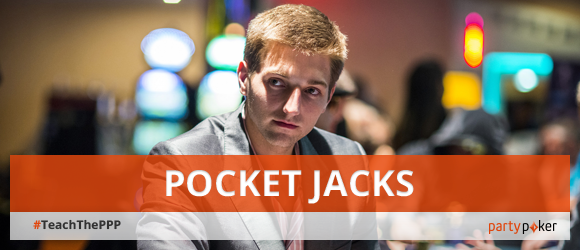by Tony Dunst
Because pocket jacks can vary from spearheading one of the strongest in the hand to being barely worth a call, they are often thought of as a ‘trouble hand’ by beginners. It’s pocket jacks’ lack of clarity that creates trouble for less experienced players.
When playing pocket jacks in tournament poker the primary factor to consider is stack size, both yours and your opponents.
In situations where you have twenty blinds or less, you’ll typically try to get all-in pre-flop unless there’s an incredible amount of action in front of you.
The situation becomes more complicated when bumped up to 30 blinds. You’re likely going to raise and probably want to get all-in pre-flop. But sometimes jacks should be just called pre-flop. If you’re a couple of seats behind with pocket jacks and thirty blinds, when a tight player raises under the gun, you should just call and proceed cautiously post-flop.
From 40 to 50 blinds a full range of plays open up. If there’s a raise in front you can call, re-re-raise with the intention to go all-in, or re-re-raise with the intention to fold – a play more seldom used as it essentially means you’ve turned pocket jacks into a bluffing hand. The jacks should be called if the opponent who open-raised is tight. If aggressive, however, you should re-re-raise with the intention of going all in or playing a larger pot post-flop.
Pocket jacks can also be an ideal hand to trap with pre-flop. If you find yourself in a situation where opponents behind you have short stacks and you’re in two minds about calling or re-raising with pocket jacks pre-flop, you should, to compel one of your opponents into going after the dead money, lean towards calling.
I won an important pot when I played jacks that way at the Bellagio $10,000 WPT event in 2012. Numerous other professionals were short-stacked and I entered day three of the tournament with an average stack. I had around 60 big blinds and a player that covered me raised in early position. I was in middle position with the jacks and elected to call, both trying to minimise my loss if the early position player had a big hand while hoping that a short-stack would shove behind.
The action folded to the button, who was sitting with a little over 20 blinds. The button went all in and, when it folded to the player who raised, I hoped he’d also fold. He thought a while and released his hand, which is when I quickly called. The player on the button had pocket sevens and was a big dog with a hand that he would’ve folded had I re-re-raised. My pocket jacks held up and I had the chips needed to make a run in the tournament.
Tagged with: beginner strategy • how to play • MTT • MTT strategy • Tony Dunst • tournament strategy


